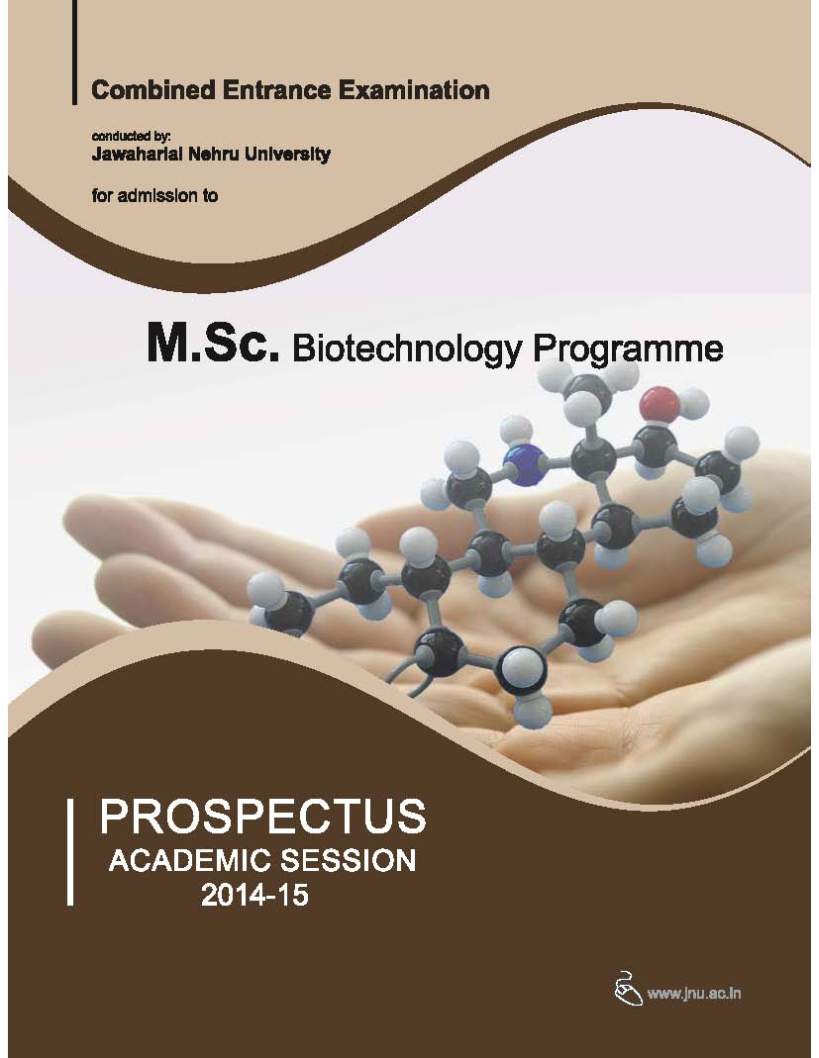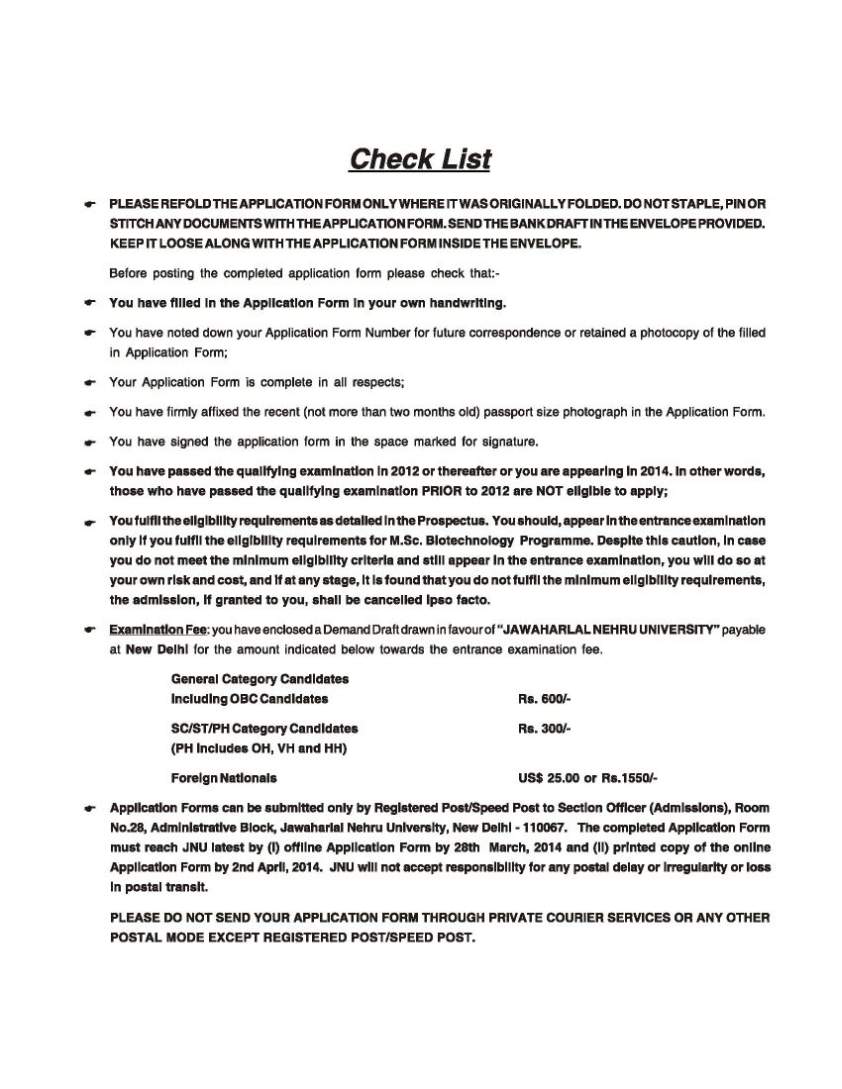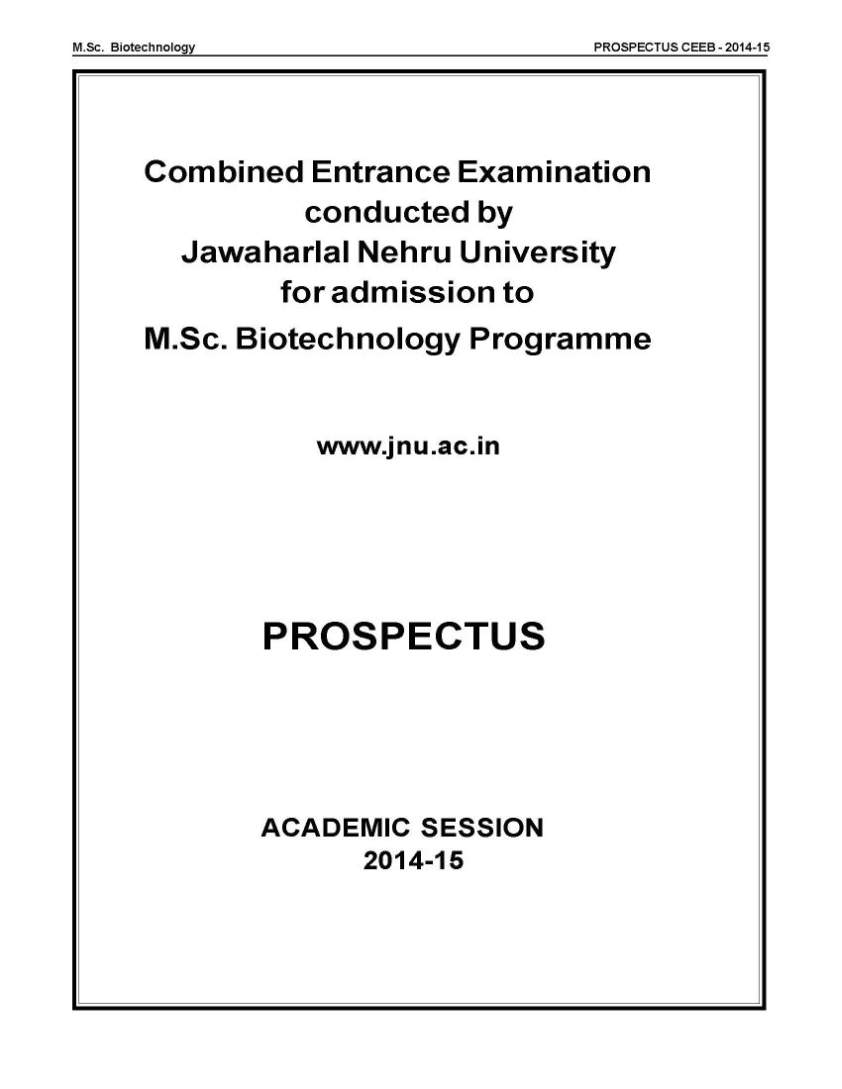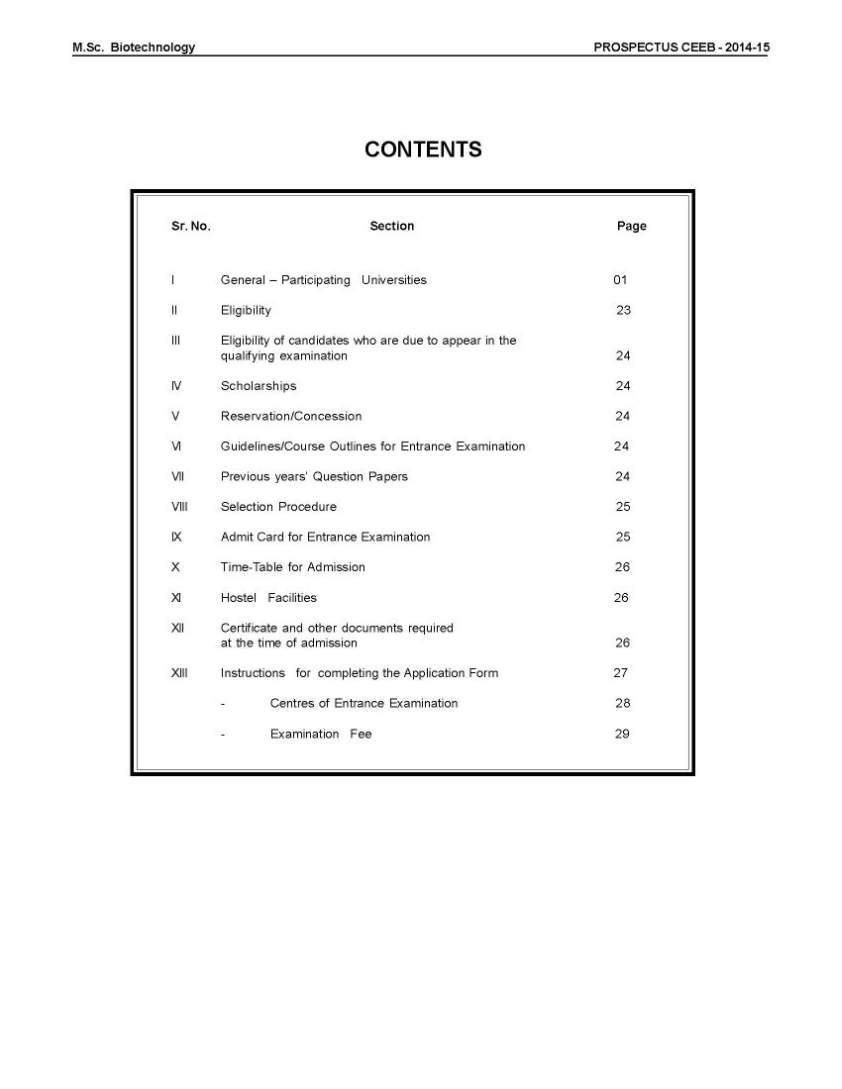| 6th November 2019 09:38 AM | |
| Neelu Bhasin | Re: JNU M.Sc Entrance Combined Biotechnology syllabus The syllabus for MSc (Computational and Integrative Sciences) - Life Sciences & Biotechnology Entrance Combined Examination of JNU (Jawaharlal Nehru University) is as follows: Part A will contain 20 questions related to basic analytical skills of Mathematics and Statistics set at the School level. All other questions will be set at the BSc level. Special focus will be on the following topics Cell Biology, Animal & Plant Biotechnology; Basic Molecular Biology and recombinant DNA technology; DNA replication, repair and recombination; Concept of the gene; transcription; translation; PCR; DNA sequencing; Gene regulation; Biomolecules; Principles of Genetics; Microbiology; Metabolism and enzymes Basic Biotechniques Basics of Bioinformatics and sequence analysis; Sequence Alignment and Clustering Algorithms; Phylogenetics; Genome databases; Engineering (including Computer) Sciences Only the following topics will be considered for the entrance examination: Basic Circuit Theory and Network Analysis Basic Circuit Concepts: Voltage and Current Sources, Resistors: Fixed and Variable resistors, Construction and Characteristics, Color coding of resistors, resistors in series and parallel. Inductors: Self and mutual inductance, Faradays law and Lenzs law of electromagnetic induction, Energy stored in an inductor, Inductance in series and parallel Capacitors: Principles of capacitance, Parallel plate capacitor, Permittivity, Definition of Dielectric Constant, Dielectric strength, Energy stored in a capacitor, Air, Paper, Mica, Teflon, Ceramic, Plastic and Electrolytic capacitor, capacitors in series and parallel, factors governing the value of capacitors Circuit Analysis: Kirchhoffs Current Law (KCL), Kirchhoffs Voltage Law (KVL), Node Analysis, Mesh Analysis, Star-Delta Conversion Network Theorems: Principal of Duality, Superposition Theorem, Thevenins Theorem, Nortons Theorem, Reciprocity Theorem, Millmans Theorem, Maximum Power Transfer Theorem. Two Port Networks: Impedance (Z) Parameters, Admittance (Y) Parameters, Transmission (ABCD) Parameters Semiconductor Devices Semiconductor Basics: Introduction to Semiconductor Materials, Crystal Structure, Planes and Miller Indices, Energy Band in Solids, Concept of Effective Mass, Density of States, Carrier Concentration at Normal Equilibrium in Intrinsic Semiconductors, Derivation of Fermi Level for Intrinsic & Extrinsic Semiconductors, Donors, Acceptors, Dependence of Fermi Level on Temperature and Doping Concentration, Temperature Dependence of Carrier Concentrations. Carrier Transport Phenomena: Carrier Drift, Mobility, Resistivity, Hall Effect, Diffusion Process, Einstein Relation, Current Density Equation, Carrier Injection, Generation And Recombination Processes, Continuity Equation P-N Junction Diode: Formation of Depletion Layer, Space Charge at a Junction Zener and Avalanche Junction Breakdown Mechanism. Tunnel diode, varactor diode, solar cell: circuit symbol, characteristics, applications Power Devices: UJT, Basic construction and working, Equivalent circuit, intrinsic Standoff Ratio, Characteristics and relaxation oscillator-expression SCR, Construction, Working and Characteristics, Triac, Diac, IGBT, MESFET, Circuit symbols, Basic constructional features, Operation and Applications Digital Electronics Number System and Codes: Decimal, Binary, Hexadecimal and Octal number systems, base conversions, Binary, octal and hexadecimal arithmetic (addition, subtraction by complement method, multiplication), representation of signed and unsigned numbers, Binary Coded Decimal code. Logic Gates and Boolean algebra: Introduction to Boolean Algebra and Boolean operators, Truth Tables of OR, AND, NOT, Basic postulates and fundamental theorems of Boolean algebra, Truth tables, construction and symbolic representation of XOR, XNOR, Universal (NOR and NAND) gates. Digital Logic families: Fan-in, Fan out, Noise Margin, Power Dissipation, Figure of merit, Speed power product, TTL and CMOS families and their Comparison Computer Science : Fundamental Concepts in C:Functions, Arrays and Pointers, Structure, Union, Enumeration and Files. Introduction to OOP and C++:Classes, objects, constructors and destructors, Operator overloading and Inheritance. Introduction to Data structures: Linked List, Stack, and Queue, Trees, graphs. Database System Concepts and Architecture: Data Modeling Using the Entity-Relationship (ER) Model. Operating Systems: Fundamental Concepts, System Structures, Managing the System, Windows and Linux. Computer Networks: Introduction to Networks standards & Model, Topologies, Communication Media and Network Transport Systems, High Speed Network Transport and Devices for Network Connectivity, Introduction to Internet: Domain Name System (DNS); Name Servers, Electronic Mail - Architecture and Services, User Agent, Message Formats, Simple Male Transfer Protocol (SMTP), POP3; FTP, TELNET, World Wide Web and Hyper Text Transfer Protocol, Network Management. Electromagnetics Vector Analysis: Scalars and Vectors, Vector Algebra, Rectangular (Cartesian) Coordinate System, Vector Components and Unit Vector, Vector Field, Products, Cylindrical Coordinates, Spherical Coordinates, Differential Length, Area and Volume, Line Surface and Volume integrals, Del Operator, Gradient of a Scalar, Divergence and Curl of a Vector, the Laplacian. Electrostatic Fields: Coulombs Law and Electric Field, Field due to Discrete and Continuous Charge Distributions, Electric Flux Density, Gausss Law and Applications, Divergence Theorem and Maxwells First Equation. Electric Potential, Potential due to a Charge and Charge distribution, Electric dipole. Electric Fields in Conductors, Current and Current Density, Continuity of Current, Metallic Conductor Properties and Boundary Conditions, Method of Images. Dielectric materials, Polarization, Dielectric Constant, Isotropic and Anisotropic dielectrics, Boundary conditions, Capacitance and Capacitors. Electrostatic Energy and Forces Magnetostatics: BiotSaverts law and Applications, Magnetic dipole, Amperes Circuital Law, Curl and Stokes Theorem, Maxwells Equation, Magnetic Flux and Magnetic Flux Density, Scalar and Vector Magnetic Potentials. Magnetization in Materials and Permeability, Anisotropic materials, Magnetic Boundary Conditions, Inductors and Inductances, Magnetic Energy, Magnetic Circuits Inductances and Inductors, Magnetic Energy, Forces and Torques Electronic communication: Block diagram of an electronic communication system, electromagnetic spectrum-band designations and applications, need for modulation, concept of channels and base-band signals. Concept of Noise, Types of Noise, Signal to noise ratio, Noise Figure, Noise Temperature, Friss formula Pulse Analog Modulation: Channel capacity, Sampling theorem, PAM, PDM, PPM modulation and detection techniques, Multiplexing, TDM and FDM. Pulse Code Modulation: Need for digital transmission, Quantizing, Uniform and Nonuniform Quantization, Quantization Noise, Companding, Coding, Decoding, Regeneration Block diagram of digital transmission and reception, Information capacity, Bit Rate, Baud Rate and M-ary coding. Optical Communication: Introduction of Optical Fiber, Types of Fiber, Guidance in Optical Fiber, Attenuation and Dispersion in Fiber, Optical Sources and Detectors, Block Diagram of optical communication system, optical power budgeting Satellite communication: Introduction, need, satellite orbits, advantages and disadvantages of geostationary satellites. Satellite visibility, satellite system - space segment, block diagrams of satellite sub systems, up link, down link, cross link, transponders (C- Band) Local area networks (LAN): Primary characteristics of Ethernet-mobile IP, OSI model, wireless LAN requirements-concept of Bluetooth, Wi-Fi and WiMAX. |
| 6th November 2019 09:36 AM | |
| Unregistered | Re: JNU M.Sc Entrance Combined Biotechnology syllabus Can you provide me the syllabus for MSc (Computational and Integrative Sciences) - Life Sciences & Biotechnology Entrance Combined Examination of JNU (Jawaharlal Nehru University)? |
| 22nd March 2015 03:04 PM | |
| Quick Sam | Re: JNU M.Sc Entrance Combined Biotechnology syllabus As you want to get JNU M.Sc Entrance Combined Biotechnology syllabus for doing preparation so here I am giving you same: UNIT I General science: Structure and properties of water. Ion product of water. Buffers, pH, pK and pI. Basic concepts on Molarity, Molality and Normality. Mean, Mode, Median, Standard deviation, Standard error and probability. Basics of computer sciences and its applications to biology. UNIT II Bio-Energetic & Biological Interaction: Laws of Thermodynamics .Concepts of heat of reaction, enthalpy, and entropy. Concept of chemical bonding, Electron displacements, Dipole-dipole interactions, hydrogen bond, Vander-Waal’s forces, hydrophobic and hydrophilic Interactions, Acid-base equilibria, Soaps and detergents. UNIT III Bio-molecules: Carbohydrates, Lipids, Proteins, Vitamins and nucleic acids-Types, structure and function. UNIT IV Cell biology: Prokaryotic and eukaryotic cell-structure and organelle functions. Functions of sub-organells of cell i.e., Nucleus, Endoplasmic reticulum, Golgi apparatus, Peroxisomes and mitochondria. Structure of Cell membrane types and regulation of transport. UNIT V Metabolism: Carbohydrate, Lipids, amino acids and nucleotides turn over and its regulation, Metabolic disorders. Glycolysis, TCA cycle, Urea cycle, Gluconeogenesis, Glyoxalate cycle and pentose phosphate pathway. UNIT VI Biological oxidations: Oxidation-reduction potentials, electron acceptors and donors in plants and animals. ATP synthesis-oxidative and photo-phosphorylation. UNIT VII Molecular Biology: Prokaryotic and eukaryotic Replication, Transcription Translation, mechanism and their regulation. DNA Repair systems. Recombination. UNIT VIII Concept of Recombinant DNA Technology : Cloning vectors: Plasmids, Bacteriophages, Cosmids, phagemids, YACs, Restriction enzymes, Ligases, PCR. UNIT IX Immunology: Innate and adaptive immunity, Antigen and super antigens. Structure and functions of immunoglobulin. T-cells and B-cells. UNIT X Bio-Techniques: Principles, types and applications of Chromatography, Centrifugation, Electrophoresis, Spectrophotometry and Blotting techniques. UNIT XI Genetics: Mendelian laws of inheritance and their application, linkage and crossing over, gene mapping, theories of mutation and evolution, Genetic disorders. UNIT XII Animal & Plant physiology: Physiology and development of circulatory, nervous system. Endocrine and exocrine system: hormone diversity and action. Transport across plant cell, Transpiration, Photosystems, Flowering, plant hormones. Plant tissue culture and production of transgenic plants UNIT XIII Microbiology: Structure and organization of microbial cells, Microbial growth, Transformation, Transduction, Conjugation. Antimicrobial agents. Drug resistance UNIT XIV Enzymology: History, general characteristics, nomenclature and classifications of enzymes, enzyme activity and factors affecting enzyme activity, Competitive and uncompetitive inhibition, allosteric enzymes. UNIT XV Cancer biology: Cell cycle progression and regulation. Receptor mediated cell Signaling. Different types of receptors, Secondary messengers. Protein modification with specific emphasis on oncogenesis. Protein modification by phosphorylation and de-phosphorylation and the role in signal transduction processes. |
| 22nd March 2015 03:03 PM | |
| Unregistered | Re: JNU M.Sc Entrance Combined Biotechnology syllabus I want to get JNU M.Sc Entrance Combined Biotechnology syllabus for doing preparation so will you please provide me that ? |
| 8th August 2014 04:11 PM | |
| Arun Vats | Re: JNU M.Sc Entrance Combined Biotechnology syllabus Here I am giving you syllabus for Jawaharlal Nehru University Combined Biotechnology Entrance Examination below : Msc Biotechnology Entrance Exam syllabus : The DBT prescribed syllabus for M.Sc. in Biotechnology is being followed. With the modern teaching aids including ICT, the students are groomed under the same roof by versatile and dedicated teachers and scientists with sound Background in genetics, Biophysics, Molecular biology, Immunotechnology, Animal biotechnology, Plant biotechnology, Microbial biotechnology, bio-informatics and comparative genomics. Combined Biotech Entrance Exam Part-A will have multiple choice type questions at the level of 10+2 in the subjects Physics, Chemistry, Mathematics and Biology The candidates will be required to attempt 60 questions Total marks for Part A will be (60 questions x 1 mark each) of 60 marks There will be negative marking and for each wrong answer, ½ (half) mark will be deducted Part-B will also have multiple-choice questions of Bachelor’s level requiring thinking and analysis There will be questions from Physics, Mathematics, Biology (e.g., Botany, Zoology, Biochemistry, Microbiology, Genetics and Molecular Biology) and Chemistry The candidates will be required to attempt 60 questions Total marks for Part-B will be 60 questions x 3 marks each = 180 marks There will be negative marking and for each wrong answer one mark will be deducted Fees to be paid at time of Admission: Rs.11756/- (Approx.) per semester Contact Address: Dr. Randhir Chakraborty, Head Department of Biotechnology, University of North Bengal, P.O. NBU, Siliguri – 734013 West Bengal Phone No. : 0353-2776354 Fax No. : 0353-2699001 E-mail : rcnbu2003@yahoo.com For more details I am attaching a PDF file with it     |
| 8th August 2014 03:54 PM | |
| Unregistered | JNU M.Sc Entrance Combined Biotechnology syllabus Provide me syllabus for Jawaharlal Nehru University Combined Biotechnology Entrance Examination ? |